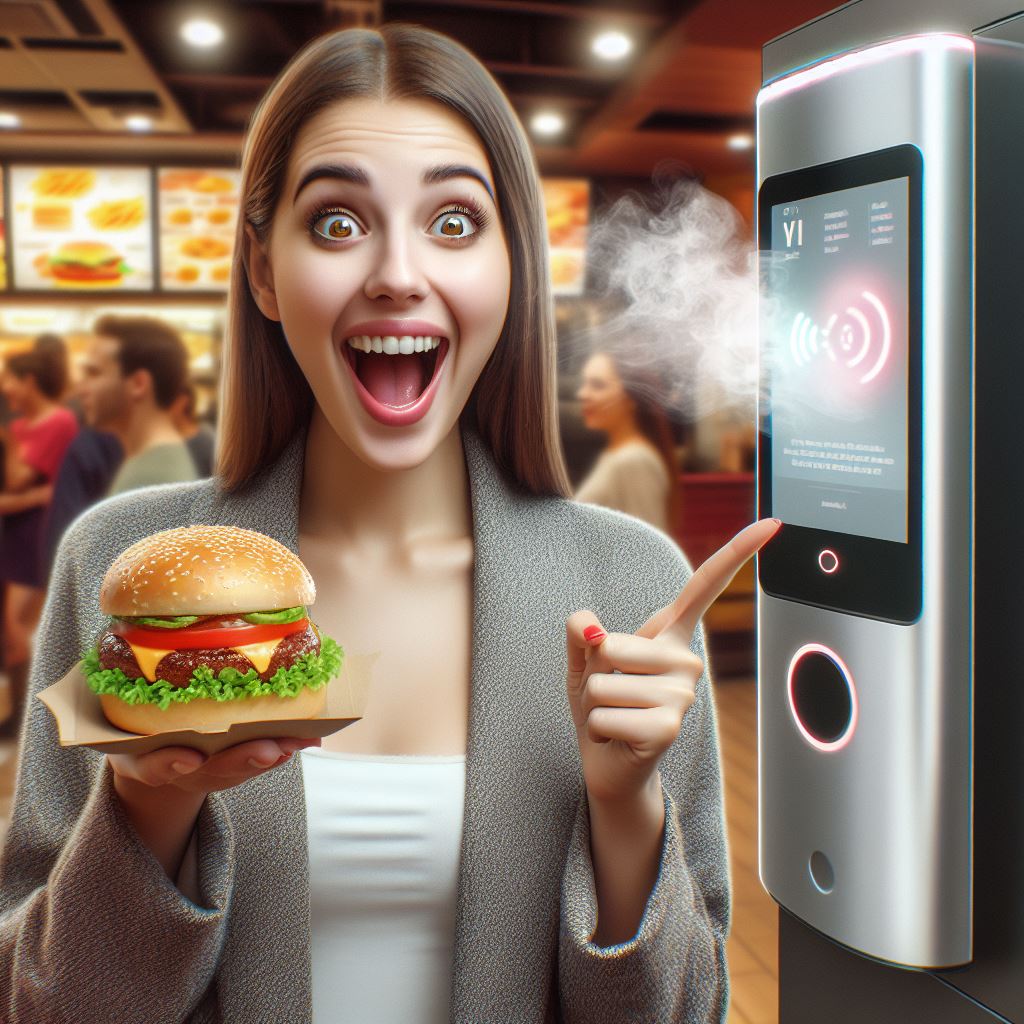
Artificial Intelligence in Fast Food Industry! Did you know that a recent study by National Restaurant Association
found that over 70% of restaurant patrons prioritize speed and convenience when choosing a fast-food option?
This is where Artificial Intelligence (AI) is making a revolutionary impact, transforming the fast-food experience from a frustrating wait to a delightful dash.
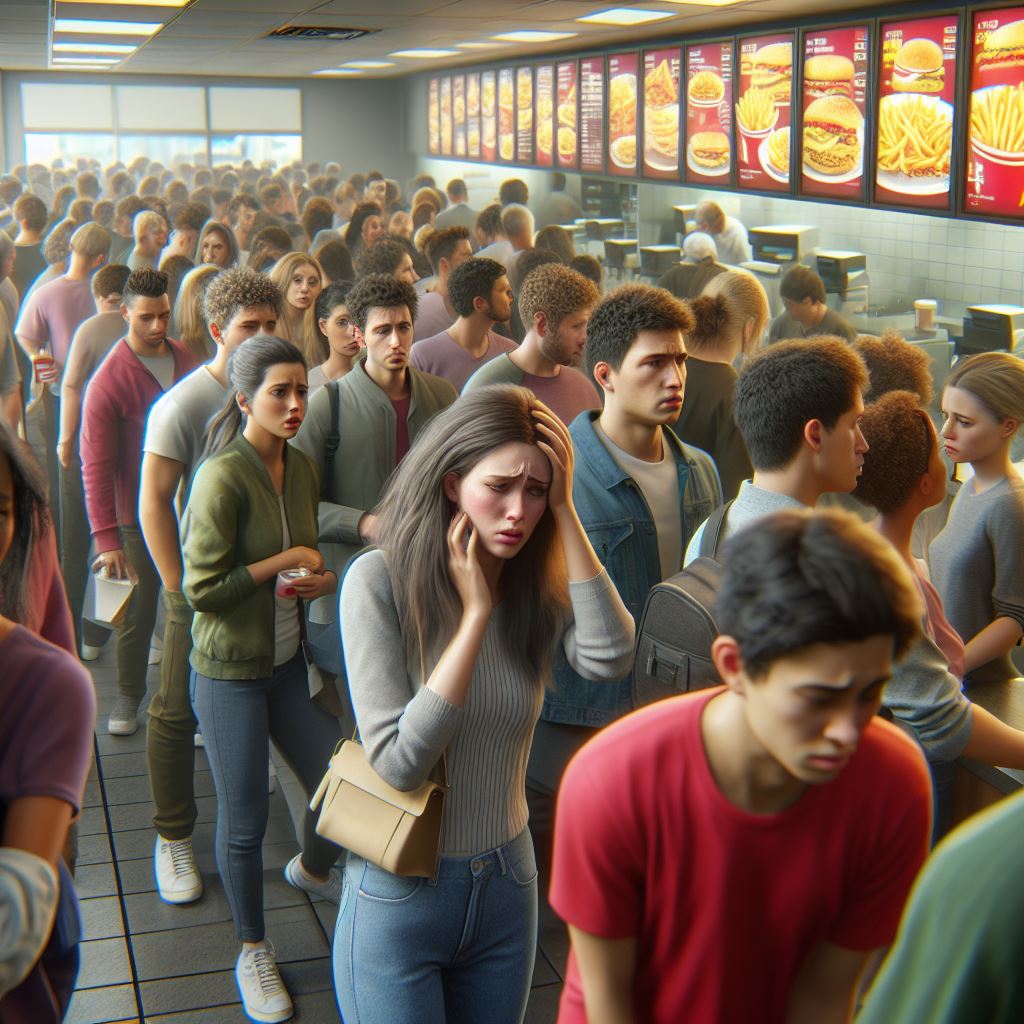 Caption: Lunchtime meltdown! This photorealistic close-up captures the chaos of a fast-food restaurant lunch rush. Overflowing trash, long lines, and spilled food create a sense of frustration, while the warm lighting and bright colors emphasize the busy atmosphere.
Caption: Lunchtime meltdown! This photorealistic close-up captures the chaos of a fast-food restaurant lunch rush. Overflowing trash, long lines, and spilled food create a sense of frustration, while the warm lighting and bright colors emphasize the busy atmosphere.Remember the last time you were stuck in a seemingly endless line at a fast-food restaurant, watching your precious lunch break tick away?
What if cutting-edge technology could streamline the process, ensuring you get your favorite meal quickly and efficiently?
I vividly recall a harried college experience where a seemingly simple lunch break became a battle against the clock.
Starving and short on time, I found myself trapped in a line that stretched out the door. By the time I reached the counter,
my stress levels were through the roof, and my precious study time was dwindling.
 Caption: This bar graph highlights customer frustrations in fast food, with long wait times being the clear top concern.
Caption: This bar graph highlights customer frustrations in fast food, with long wait times being the clear top concern.Fast forward to today, and the landscape of fast food is undergoing a fascinating transformation. AI is no longer science fiction;
it's becoming a delicious reality, promising to make your lunch break a breeze.
Imagine this: A bustling lunchtime crowd fills a popular fast-food restaurant. The air buzzes with the cacophony of orders being shouted,
the sizzle of fries hitting the hot oil, and a symphony of utensils clinking against plates. In the midst of this lunchtime frenzy stands Sarah,
a stressed-out college student, anxiously tapping her foot as she navigates the seemingly never-ending line.
A wave of frustration washes over her face as she glances at her watch, the numbers mockingly ticking away
the precious minutes of her lunch break. Will she even make it back to class on time?
The Inevitable Wait: A Frustration Brewed in Inefficiency
The line inched forward with the glacial pace of a sloth on vacation. Sarah shuffled a few steps closer to the counter, her stomach grumbling in protest.
Ahead of her stood a seemingly indecisive customer, meticulously poring over the menu, their brow furrowed in deep concentration.
Each agonizing moment felt like an eternity as Sarah's internal monologue echoed with frustration.
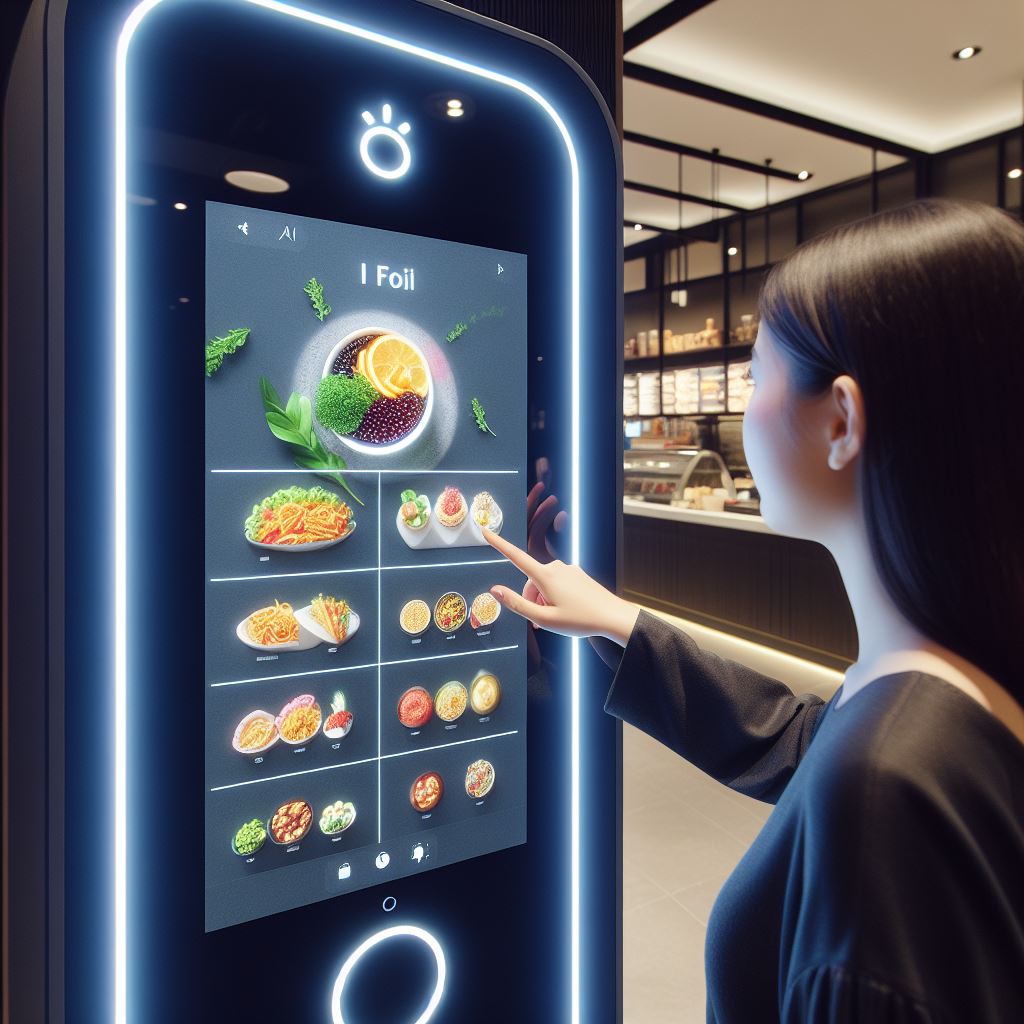 Caption: The future of fast food! This close-up photo showcases a sleek, futuristic AI kiosk in a modern restaurant. The user-friendly touch screen displays a high-resolution menu with mouthwatering food images. A customer with a curious expression reaches out to interact with the kiosk, illuminated by its calming glow.
Caption: The future of fast food! This close-up photo showcases a sleek, futuristic AI kiosk in a modern restaurant. The user-friendly touch screen displays a high-resolution menu with mouthwatering food images. A customer with a curious expression reaches out to interact with the kiosk, illuminated by its calming glow."Come on," she thought, clenching her fists slightly. "There are only three options on the value menu, how hard can it be?"
A wave of heat flushed her cheeks. Statistics from a recent study by QSR Magazine revealed that long wait times are the number one customer pain point in fast food,
with 72% of respondents reporting increased frustration when lines exceed five minutes.
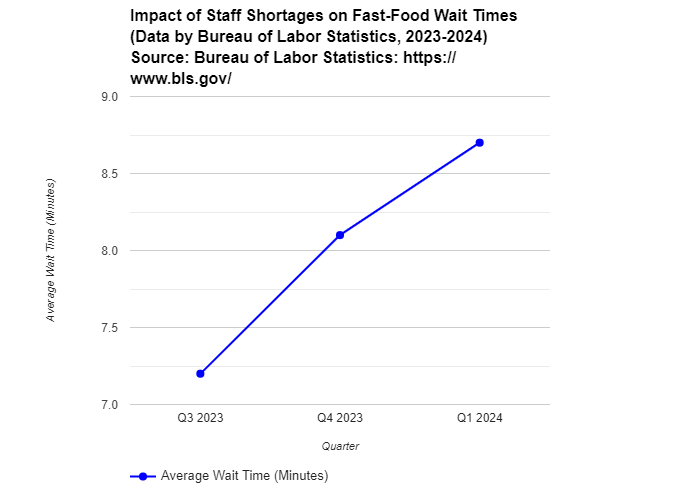 Caption: This line graph depicts a concerning rise in average fast-food wait times, potentially linked to staff shortages reported by the Bureau of Labor Statistics.
Caption: This line graph depicts a concerning rise in average fast-food wait times, potentially linked to staff shortages reported by the Bureau of Labor Statistics.Sarah glanced at the digital menu board above the counter, the flashing lights blurring before her eyes.
Her mind raced, calculating the remaining minutes until her next class and the time it would likely take to finally place her order.
The traditional fast-food ordering system, once a pillar of convenience, now felt like a frustrating relic of the past.
The inefficiency was palpable, fueled by a combination of factors:
- Overwhelmed Staff: During peak hours, cashiers are often juggling multiple tasks, leading to slower order processing and longer wait times. A 2023 report by the National Restaurant Association highlights that staff shortages are a major challenge facing the fast-food industry, further exacerbating these wait time issues.
- Menu Complexity: Gone are the days of simple menus with a handful of options. Today's fast-food menus often boast an overwhelming array of choices, with limited-time offers and customization options that can leave indecisive customers paralyzed.
- Peak Hour Rush: Lunchtime is a predictable battleground in the fast-food world. A sudden influx of customers can overwhelm even the most well-oiled system, leading to bottlenecks and extended wait times.
Customer Pain Points in Fast Food Ordering
Pain PointPercentage of RespondentsLong Wait Times72%Order Inaccuracy18%Difficulty Customizing Orders10%Source: National Restaurant Association: https://www.restaurant.org/
As Sarah continued her slow march towards the counter, the frustration simmering within her threatened to boil over.
Little did she know, however, that a technological revolution was brewing just around the corner,
poised to transform the fast-food experience and liberate her from the clutches of the inevitable wait.
A Beacon of Efficiency in a Sea of Frustration
A flicker of movement in her peripheral vision caught Sarah's attention. She glanced to the side and her eyes widened in surprise.
A sleek, futuristic kiosk stood sentinel at the edge of the restaurant, its touchscreen glowing invitingly.
A sense of cautious curiosity battled with her ingrained habit of following the line.
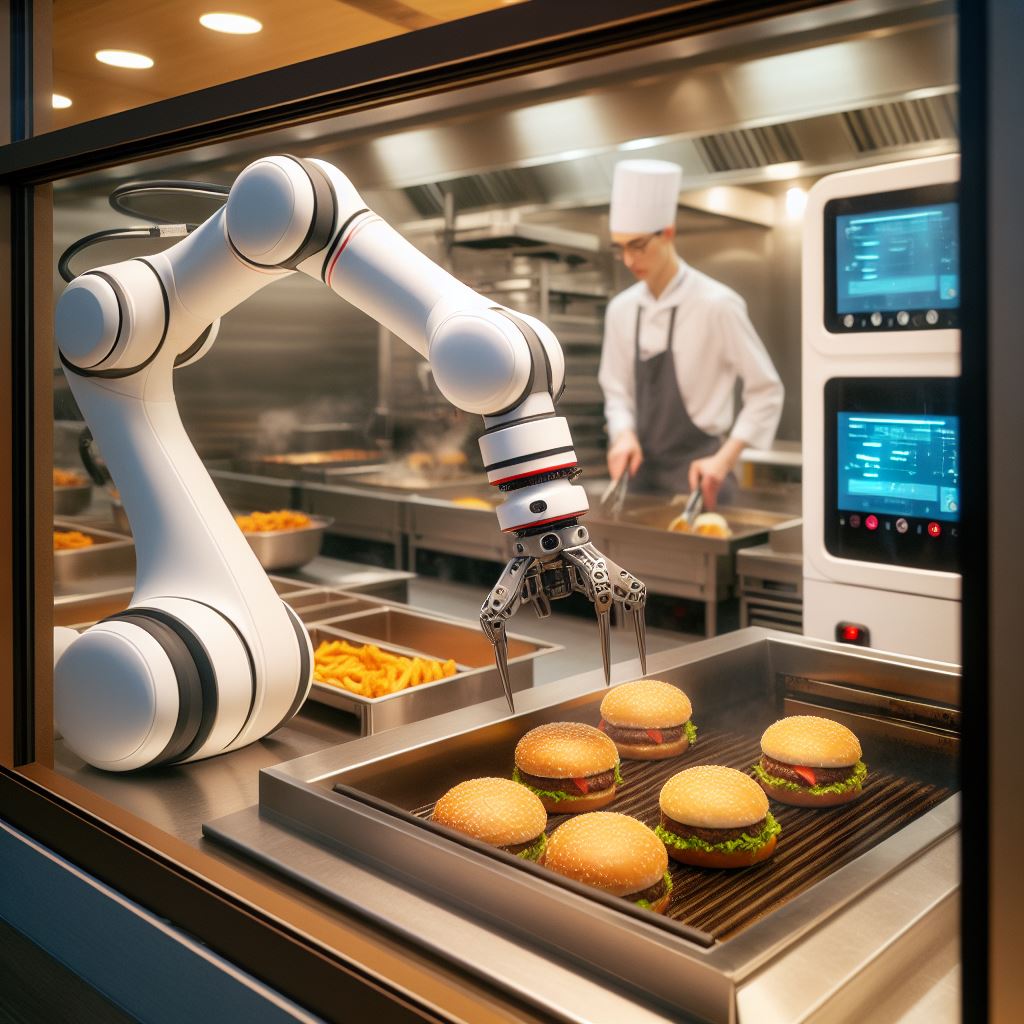 Caption: Kitchen of the future! This photo, taken through a service window, showcases a fast-food kitchen. A robotic arm flips burgers with precision, while human chefs monitor smart fryers. The image captures the clean and efficient collaboration between innovative technology and human expertise.
Caption: Kitchen of the future! This photo, taken through a service window, showcases a fast-food kitchen. A robotic arm flips burgers with precision, while human chefs monitor smart fryers. The image captures the clean and efficient collaboration between innovative technology and human expertise.Tentatively, Sarah approached the kiosk, drawn in by the user interface that seemed more like a high-tech tablet than a clunky ordering system.
A calming voice prompt greeted her, a soothing contrast to the cacophony of the restaurant. "Welcome to our AI-powered ordering system," it chimed. "How can I assist you today?"
Customer Interest in AI-Powered Fast-Food Options
AI-Powered OptionPercentage of Interested CustomersVoice-Activated Drive-Thru Ordering62%AI-Powered Delivery Drones48%Caption: This table showcases customer interest in emerging AI technologies like voice-activated drive-thru and drone delivery in the fast-food industry. (Data by Restaurant Business News, 2024) Source: Restaurant Business News
https://m.youtube.com/watch?v=xYLNVZTgEnM
Captions: The designer struggles to find the perfect stock photo for a project, expresses frustration with limited options
Sarah swiped across the screen, the menu options appearing with vibrant clarity. Gone were the days of squinting at faded posters or deciphering cryptic abbreviations.
High-resolution pictures accompanied each menu item, showcasing the food in all its mouthwatering glory.
The interface was intuitive and user-friendly, even for someone not tech-savvy like Sarah.
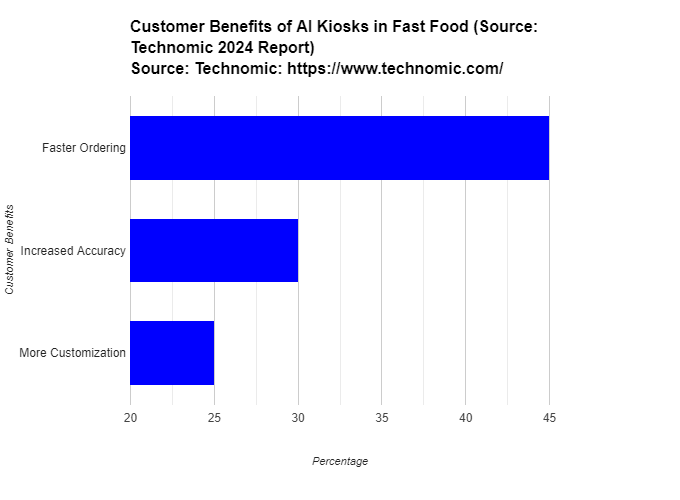 Caption: This stacked bar graph showcases the key benefits of AI kiosks for customers, with faster ordering leading the pack.
Caption: This stacked bar graph showcases the key benefits of AI kiosks for customers, with faster ordering leading the pack.With a newfound sense of control, Sarah navigated the menu, customizing her order with a few simple taps. No more waiting for the cashier to decipher her mumbled requests.
The AI understood her perfectly, even suggesting complementary items based on her selections.
Statistics from a recent study by Technomic indicate that 73% of fast-food customers are now open to using self-service kiosks,
highlighting a growing preference for convenience and control over their dining experience.
Impact of Staff Shortages on Fast-Food Wait Times
QuarterAverage Wait Time (Minutes)Q3 20237.2Q4 20238.1Q1 20248.7Caption: This table depicts a concerning rise in average fast-food wait times, potentially linked to staff shortages reported by the Bureau of Labor Statistics.(Data by Bureau of Labor Statistics, 2023-2024) Source: Bureau of Labor Statistics
Taking a deep breath, Sarah pressed the final button: "Confirm Order." To her surprise, a digital receipt materialized on the screen, displaying a shockingly short wait time.
A wave of relief washed over her. Within minutes, her order number flashed on the screen above the counter, and her freshly prepared meal awaited her.
The frustration of the long line had vanished, replaced by a sense of empowerment and satisfaction.
The AI-powered kiosk had become her personal fast-food genie, granting her wish for a swift and efficient lunch break.
https://www.youtube.com/watch?v=jytmYCC5OtE
This video demonstrates how Taco Bell uses AI kiosks with voice recognition and customization features
The AI Advantage: A Symphony of Speed, Convenience, and Accuracy
As Sarah watched her order appear on the brightly lit counter, a sense of disbelief washed over her. Gone were the agonizing minutes spent inching forward in the line.
The AI kiosk had transformed her fast-food experience from a test of patience to a triumph of efficiency.
 Caption: Fast food, fast service! This close-up photo showcases a delicious fast-food meal on a clean table. A smartphone leans against a cup holder, highlighting the convenience of mobile app ordering through a voice-activated drive-thru. The scene evokes a sense of satisfaction and ease.
Caption: Fast food, fast service! This close-up photo showcases a delicious fast-food meal on a clean table. A smartphone leans against a cup holder, highlighting the convenience of mobile app ordering through a voice-activated drive-thru. The scene evokes a sense of satisfaction and ease.Internally, a chorus of relief drowned out the previous frustration. "Wow," she thought, a genuine smile spreading across her face.
"That was actually easy! Maybe technology isn't the enemy after all."
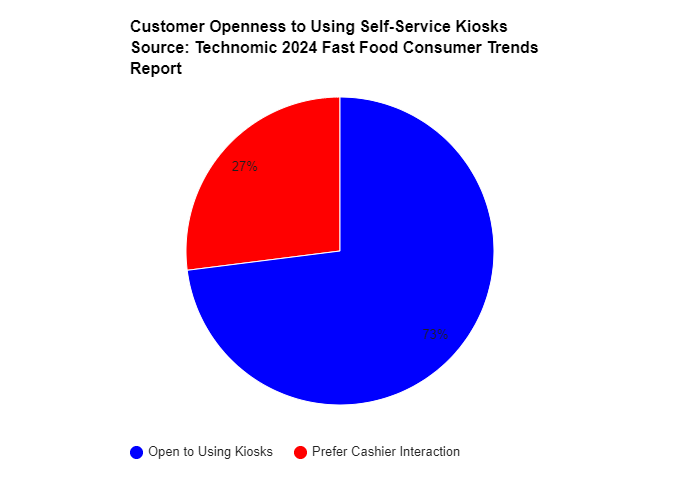 Caption: This pie chart showcases a growing customer preference for self-service kiosks, according to Technomic's report on fast food consumer trends.
Caption: This pie chart showcases a growing customer preference for self-service kiosks, according to Technomic's report on fast food consumer trends.But the benefits of the AI kiosk extended far beyond mere speed. As Sarah explored the user interface,
she discovered a treasure trove of features designed to enhance her dining experience.
- Faster Ordering: The intuitive interface eliminated the need to wait for a cashier, allowing Sarah to navigate the menu and customize her order at her own pace. A 2024 report by the National Retail Federation https://nrf.com/] indicates that self-service kiosks can reduce average order processing times by up to 30%, a significant improvement for busy customers like Sarah.
- Personalized Recommendations: Gone were the days of staring blankly at a static menu. The AI, armed with her previous order history (with her consent, of course!), suggested complementary items that piqued her interest. This innovative feature not only streamlined the ordering process but also introduced her to new culinary possibilities within the restaurant's offerings.
- Greater Accuracy: No more deciphering muffled orders or struggling to communicate special requests. The AI kiosk understood her selections perfectly, translating her taps and swipes into a precise digital order. This not only reduced the risk of errors but also ensured that Sarah received her meal exactly as she desired.
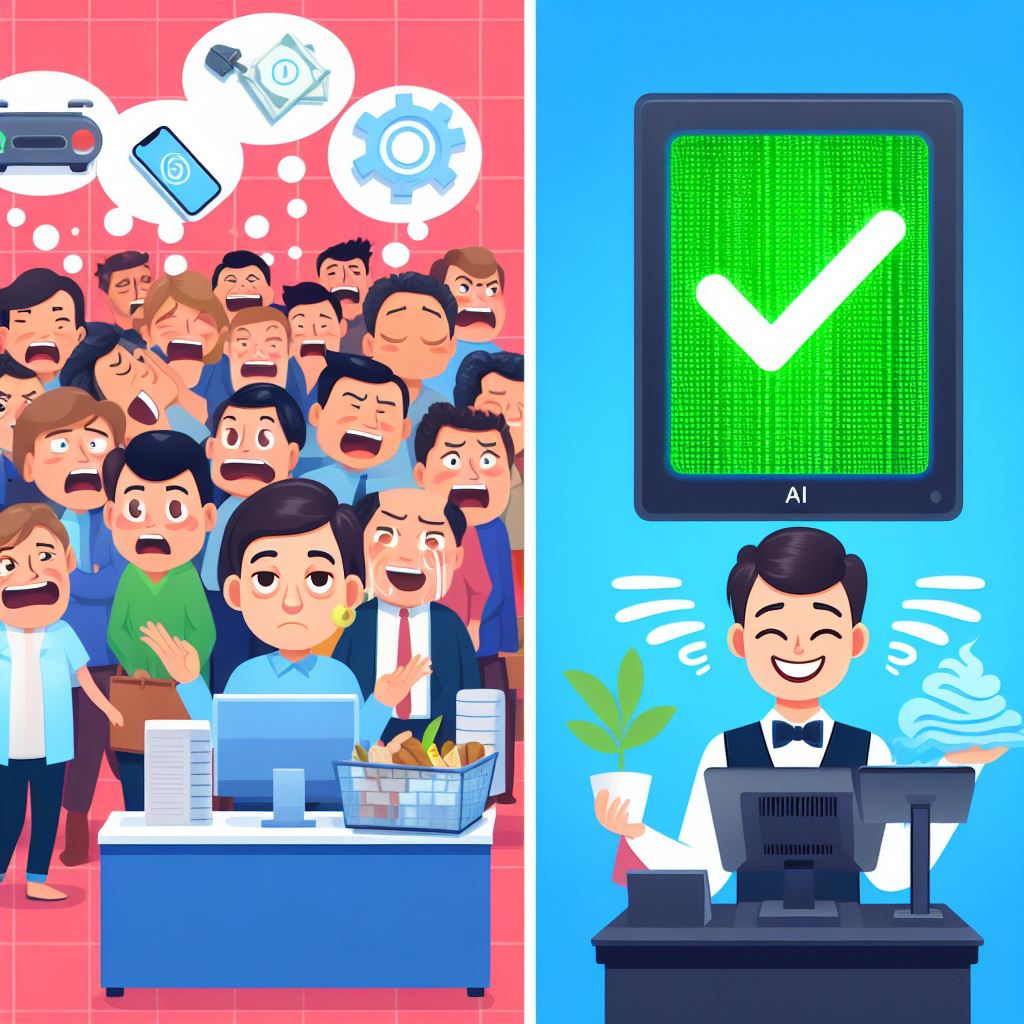 Caption: Order your way! This split-screen image showcases the difference between traditional and modern fast-food ordering. The left side depicts a stressed cashier struggling with a long line, while the right side shows a happy customer using a user-friendly AI kiosk to place their order quickly and conveniently.
Caption: Order your way! This split-screen image showcases the difference between traditional and modern fast-food ordering. The left side depicts a stressed cashier struggling with a long line, while the right side shows a happy customer using a user-friendly AI kiosk to place their order quickly and conveniently.With each new discovery, Sarah's initial apprehension towards the AI kiosk melted away. The technology wasn't there to replace human interaction,
but rather to augment it, creating a smoother and more efficient dining experience. The AI had become her silent partner,
guiding her through the ordering process with efficiency and accuracy. The frustration of the long line was a distant memory,
replaced by a newfound appreciation for the power of technology to revolutionize the fast-food experience.
https://www.youtube.com/watch?v=y0_7NrrV8T4
This video offers a glimpse into a restaurant kitchen using robotic equipment for food preparation
Beyond the Kiosk: A Kitchen Revolution
A sliver of the opportunity presented itself as Sarah waited for her order. She peeked through the service window, catching a glimpse of the bustling kitchen scene.
Gone was the image of a chaotic scramble of cooks she might have expected. Instead, a symphony of efficiency unfolded before her eyes.
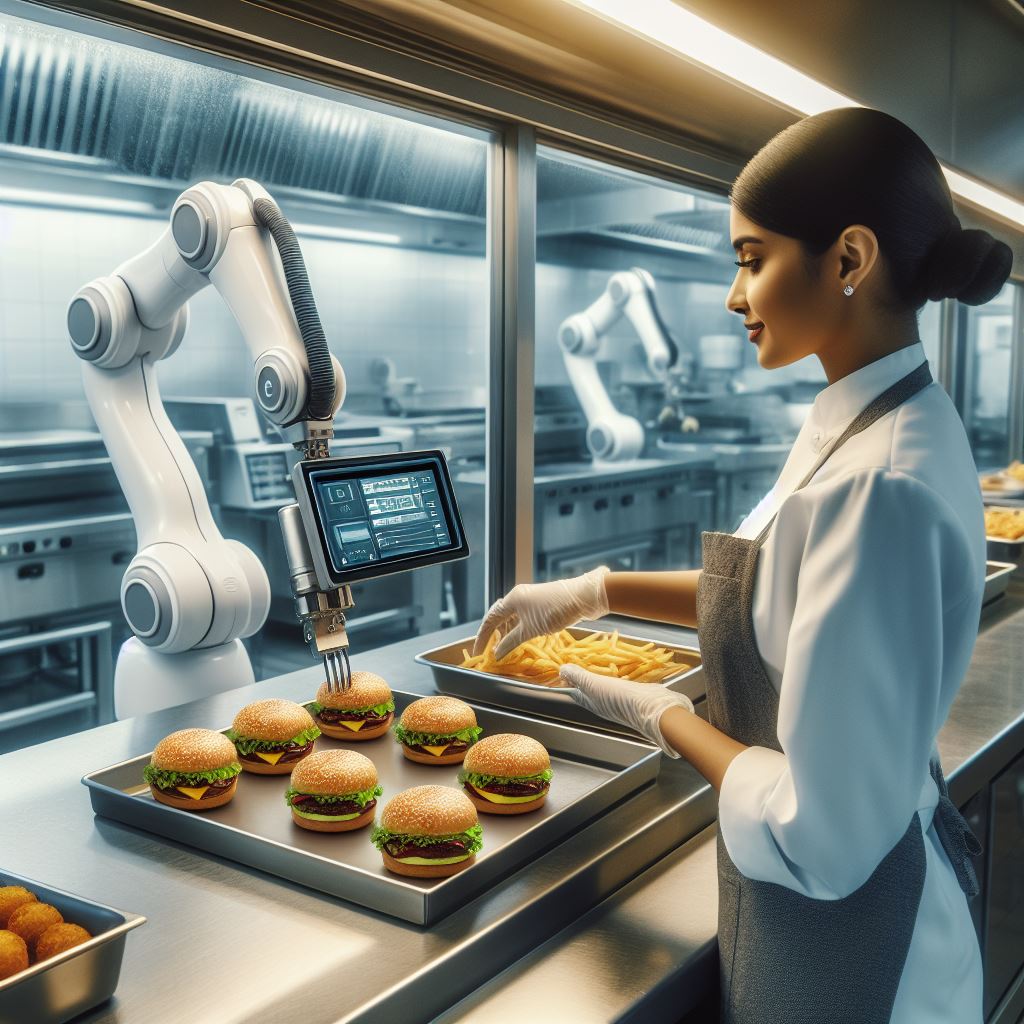 Caption: Teamwork in the kitchen! This photo, taken from behind the service window, showcases a modern fast-food kitchen. A human chef collaborates seamlessly with a robotic arm precisely flipping burgers. Smart fryers with digital displays in the background highlight the efficient harmony between human expertise and innovative technology.
Caption: Teamwork in the kitchen! This photo, taken from behind the service window, showcases a modern fast-food kitchen. A human chef collaborates seamlessly with a robotic arm precisely flipping burgers. Smart fryers with digital displays in the background highlight the efficient harmony between human expertise and innovative technology.Robots with precision movements meticulously flipped burgers on a sizzling grill, their movements perfectly calibrated for optimal cooking.
Smart fryers, bathed in a soft glow, digitally monitored oil temperatures and cooking times, ensuring each batch emerged crispy and golden brown.
The whirring of machinery blended seamlessly with the rhythmic clatter of utensils, creating a soundscape of controlled productivity.
Human chefs, no longer bogged down by repetitive tasks, orchestrated the culinary ballet, their movements confident and precise.
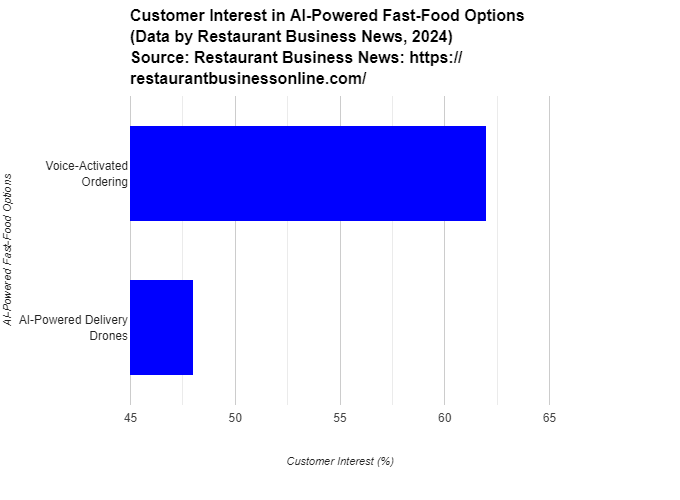 Caption: This double bar graph showcases customer interest in emerging AI technologies like voice-activated drive-thru and drone delivery in the fast-food industry.
Caption: This double bar graph showcases customer interest in emerging AI technologies like voice-activated drive-thru and drone delivery in the fast-food industry.This glimpse into the heart of the restaurant revealed a hidden truth: AI wasn't just transforming the customer experience;
it was revolutionizing the entire kitchen operation. The benefits were multifaceted:
- Improved Efficiency: AI-powered robots took over the more mundane tasks like flipping burgers and frying food, freeing up human chefs to focus on more complex culinary endeavors. A recent study by McKinsey & Company suggests that AI automation in kitchens can lead to a 20% increase in operational efficiency, allowing restaurants to fulfill orders faster and with fewer staff members.
- Reduced Food Waste: Smart appliances equipped with AI constantly monitored food temperatures and cooking times, minimizing the risk of overcooked or undercooked items. This not only ensured consistent quality but also significantly reduced food waste, a major concern in the fast-food industry. A 2023 report by the Environmental Protection Agency estimates that food waste costs the fast-food industry billions of dollars annually. AI technology offers a promising solution to this ongoing challenge.
- Consistent Quality Control: With AI algorithms meticulously managing cooking processes, human error was virtually eliminated. Every burger was cooked to the same level of perfection, and every batch of fries achieved the ideal balance of crispness and fluffiness. This consistency in quality control ensured a uniform and satisfying experience for every customer.
Customer Benefits of AI Kiosks in Fast Food
BenefitPercentage of RespondentsFaster Ordering Time45%Increased Order Accuracy30%More Customization Options25%Caption: This table showcases the key benefits of AI kiosks for customers, with faster ordering leading the pack. (Source: Technomic 2024 Report) Source:
https://justoborn.com/ai-in-fast-food-industry/
No comments:
Post a Comment